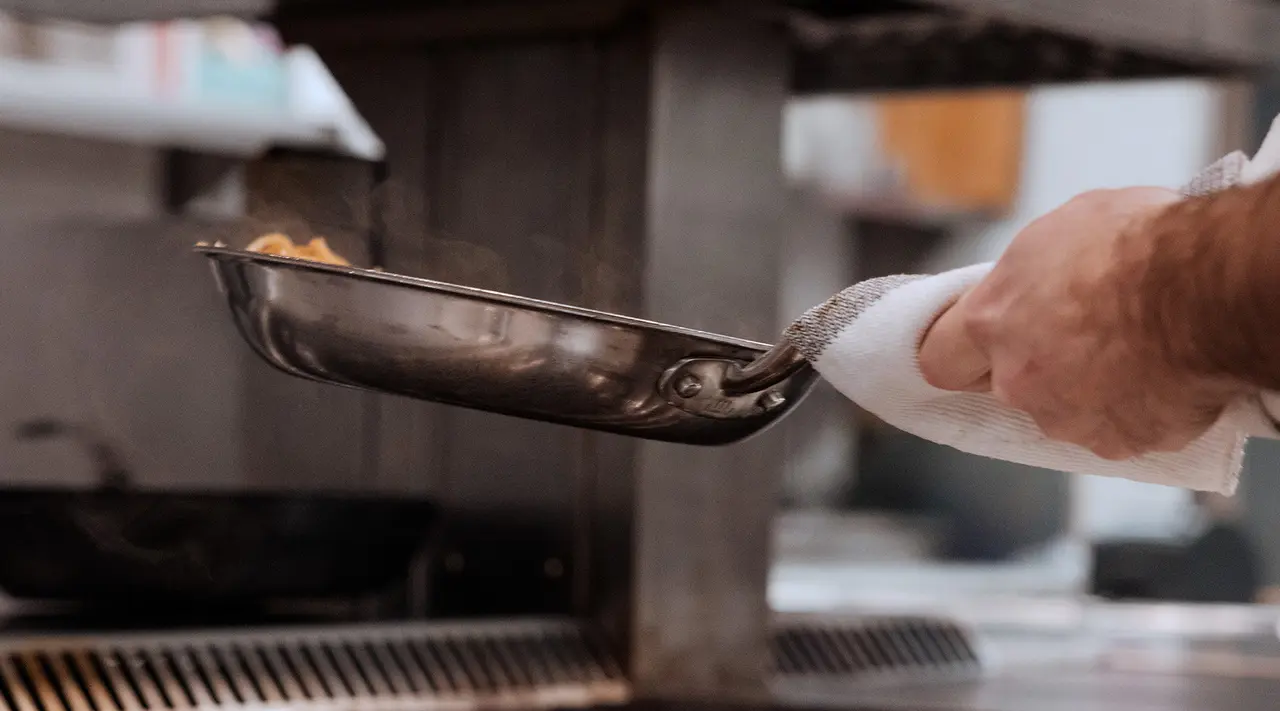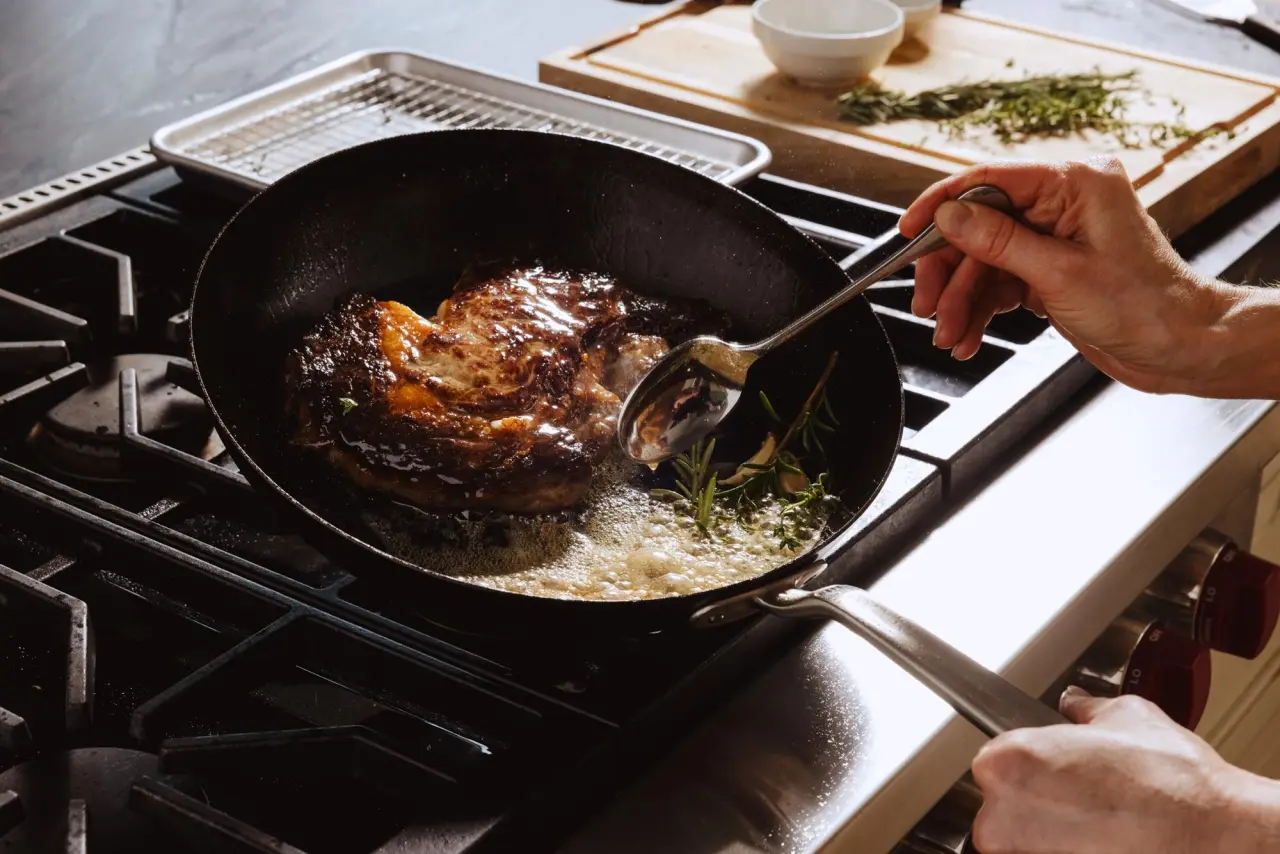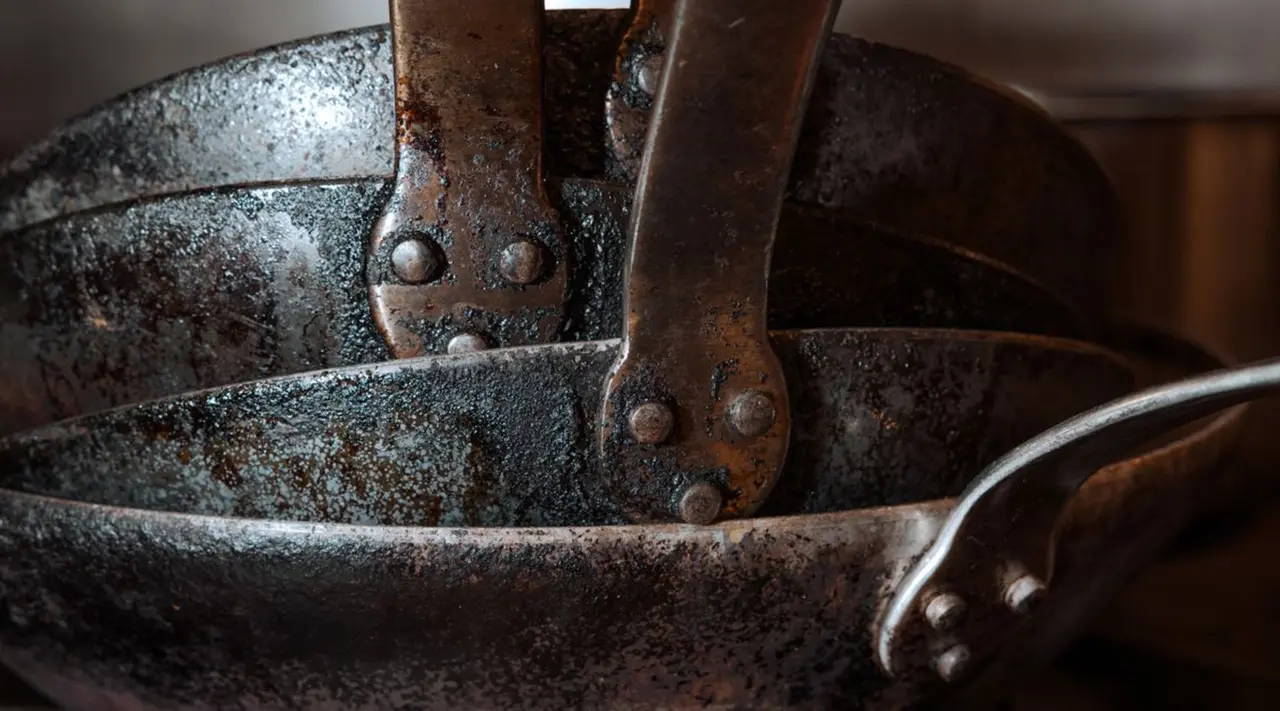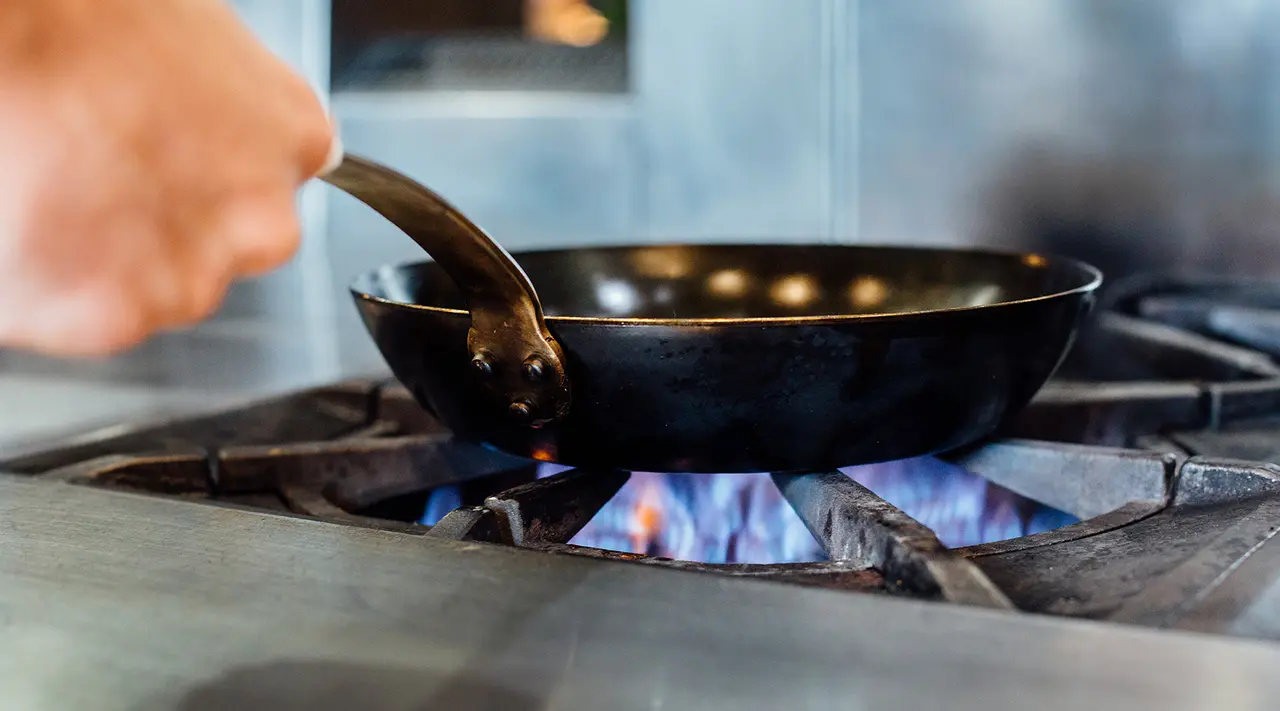Stainless steel pans are widely considered some of the best pieces of cookware you can buy, both by professional chefs and home cooks. Lightweight, sturdy, and incredibly durable, they tackle everything from steaks to stir-fries with ease. This is because they’re made from a combination of stainless steel (obviously), a strong, virtually rust-proof metal, as well as highly conductive metals like aluminum and aluminum alloy.
Another reason they're so beloved is they’re not especially high-maintenance—once you know what you're doing. Here’s our complete guide to cleaning, storing, and cooking with your stainless steel pan.
Understanding Stainless Steel Pans
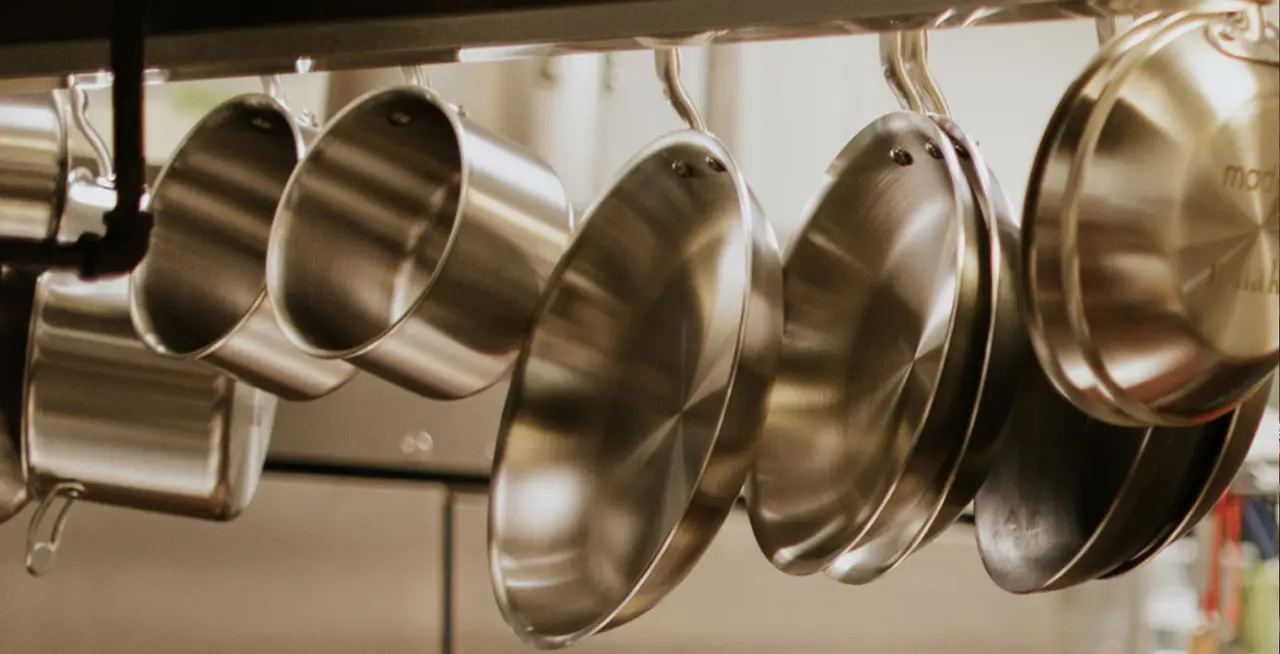
Stainless steel cookware is typically made with several layers, or “ply,” of metals like aluminum and aluminum alloy, finished with a layer of stainless steel that serves as the cooking surface. This construction makes for a pan with excellent heat conductivity and circulation, as well as stellar durability and resistance to scratches and warping.
Why Proper Care Is Essential
While stainless steel pans—especially 5-ply stainless clad pans like ours—are virtually indestructible, they’ll cook better and last even longer if you know how to care for them.
Here are some of the most common mistakes you can make with your stainless steel cookware—and how you can easily avoid them.
- Running your stainless steel pan through the dishwasher can damage the finish and warp your pan. Even if your pan is labeled “dishwasher-safe,” handwashing is the best way to keep it safe from damage.
- Not giving your pan time to cool down before running it under cold water can cause it to warp due to thermal shock. For this same reason, you should allow your food to come to room temperature before adding it to your (preheated) pan.
- Salting water before it has come to a boil or adding salt to a cold pan before it's heated can lead to pitting, which—while it won’t affect your pan’s performance—is both unsightly and permanent.
- Cleaning your pan with abrasive products like bleach. Because bleach is corrosive, it can damage the protective layer of chromium oxide on stainless steel cookware. You should avoid steel wool or similar harsh scrubbers for this reason.
How to Clean Stainless Steel Pans
The easiest way to keep your pan in tip-top shape is by following a regular cleaning routine, making sure to tackle all messes and stains as soon as they happen.
Daily Cleaning Routine
Before you try any other cleaning methods, first wash your pan out with warm water, a few drops of gentle dish soap, and a soft sponge. This is typically all you’ll need to take care of everyday messes like food residue and leftover oil.
You can always add a little bit of elbow grease for more stubborn messes, such as burnt-on food or heavy stains and discoloration: see the below methods for how to tackle these. We also have an dedicated guide to cleaning dirty pans, broken down by the level of mess.
How to Remove Stubborn Residue
You have a few options when it comes to removing stubborn residue from the surface of your pans.
Stainless Steel Cleaner
- Pour a small amount of our Stainless Steel Cleaner or another powdered kitchen cleaner into your dirty pan, then use a soft sponge or other non-abrasive tool to work the powder into the pan.
- Once you’ve loosened as much of the mess as you can, rinse thoroughly with warm water and dry thoroughly.
Baking Soda and Vinegar
This method is a solid substitute for Stainless Steel Cleaner if you don’t have any on hand.
- Sprinkle enough baking soda onto your pan to cover the affected areas, using a sponge to scrub the pan out as well as possible.
- Add distilled white vinegar to the layer of baking soda, and it should foam up—which will help loosen the stuck-on residue.
- Rinse and dry thoroughly.
Boiling Water and Vinegar
If you’ve already tried one of the above cleaning methods and your pan is still dirty, here’s another method to try.
- Add enough water to your pan to cover the bottom, let it come up to a boil.
- While boiling, use a wooden spoon or other non-abrasive tool to scrape the bottom of the pan, loosening as much of the burnt-on food as possible.
- If the mess is particularly stubborn, you can try starting over with a 1:1 mix of vinegar and water.
- Bring this to a boil, and try scraping the pan until it’s completely clean.
- Rinse and dry.
Common Issues When Cleaning Stainless Steel
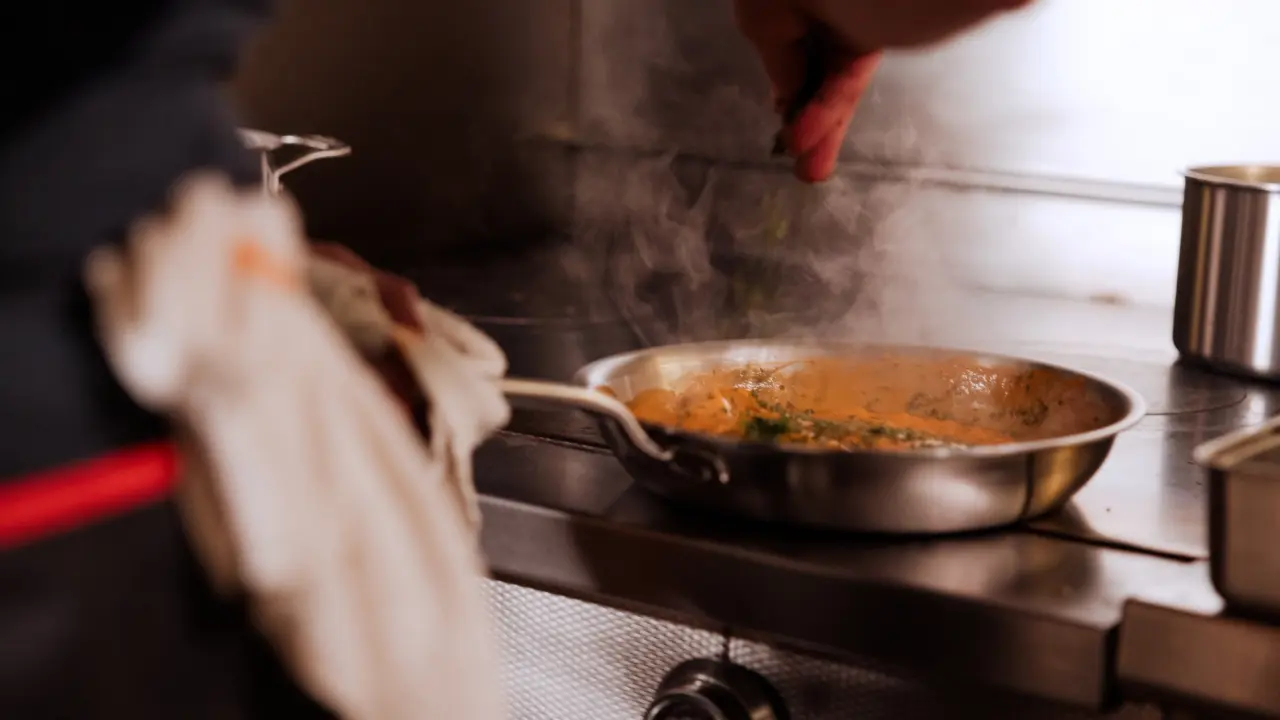
While you’ll be able to tackle the vast majority of messes using the cleaning methods above, there are certain situations—like rainbow stains, aka “heat tint” —where you’ll need to get a little more creative. Here’s how to spot these issues, and what to do about them
Heat Tint (aka Rainbow Stains)
True to the name, these rainbow splotches (similar to the effect of oil on water) form on your pan when stainless steel is heated to very high temperatures. This is due to the small amount of chromium used to keep stainless steel from rusting, which can thicken when it’s exposed to high heat, causing your pan to take on a rainbow appearance.
These impermanent stains are purely aesthetic and have no affect your pan’s performance in any way—though if you prefer the look of unmarred stainless steel, there’s an easy way to get rid of these stains.
Water Spots and Calcium Deposits
Water spots—also called calcium deposits, mineral deposits, or limescale—form on the surface of your pan due to dissolved minerals commonly found in "hard" tap water. When the water dries, minerals like magnesium or calcium remain behind, leaving a chalky white mark on your pan.
Like heat tint, these impermanent deposits won’t negatively affect your pan’s performance—though they can eventually cause bacterial growth if left to build up over time. Luckily, removing them is just as easy as getting rid of heat tint. Here’s our full guide to removing calcium deposits from your stainless steel cookware.
Additional Stainless Steel Pan Care Tips
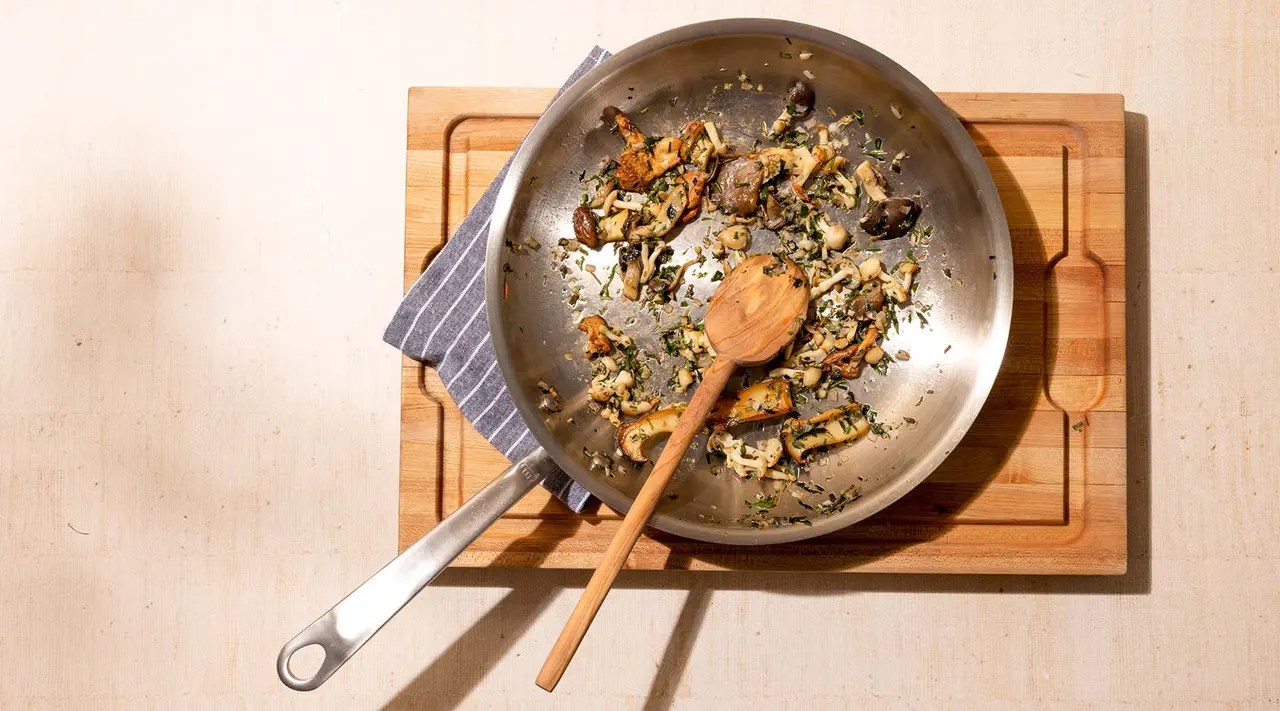
Along with proper cleaning techniques, there are a few other things you can do to avoid common stainless steel misfires—namely, how to cook with and store your pan.
Proper Preheating Techniques
While stainless steel isn’t as stick-resistant as non stick or well-seasoned carbon steel, you can prevent sticking to some extent—and one of the most effective ways to do that is by always preheating your pan before adding your food.
Before adding oil, set your pan over medium-low heat for a few minutes, then check to see if it’s hot enough by splashing small drops of water onto the surface. The drops should bead up and roll or dance (not scatter) across the surface. If the water sits on the surface of the pan, it needs to heat more; if it immediately starts steaming or scatters, the pan is too hot. Once it's just right, add your oil and wait for a minute or two until it shimmers before adding your ingredients.
Recommended Cooking Temperatures
One of the many great things about stainless steel—and one of the reasons we’re constantly reaching for it—is that it’s incredibly heat-resistant. Our Stainless Clad products are all oven-safe up to 800F, which means you can safely transfer your steaks to the oven after searing.
While you run the risk of heat tint at such high temperatures, you generally don’t need to worry about warping or other serious damage—especially not with fully-cladded pans. Just make sure to always temper your ingredients and preheat your pan before cooking, and if heat tint does happen you're now well-equipped to take care of it.
How to Store Stainless Steel Pans
After you’ve successfully removed the grease, grime, and any stubborn stains from your stainless steel pan, it’s time to think about storage. But don’t just shove it in a drawer: first, check to see if it’s totally dry. While stainless steel rarely rusts, putting a pan away without fully drying it first can leave calcium deposits in the spots where the water has dried up.
Now decide whether you’ll stack or hang your pan. Hanging is the easiest way to avoid scratches or other damage, but if you do decide to stack, or “nest,” your pan, make sure to lay a trivet, dish towel, Pan Protector, or napkin inside—as well as underneath—your pan to keep it protected.
Ready to Shop?
Whether you’re new to the world of stainless steel cookware, or you’re just getting started, allow this guide to serve as your compass: now you can face down everyday messes, scour away burnt food, and remove unsightly stains without fear.
And while proper maintenance and cleaning can always help you get more life out of your cookware, starting with a really excellent pan makes this even easier: grab one of our 5-Ply Stainless Clad pans, and say goodbye to flimsy, unreliable stainless steel cookware for good.
